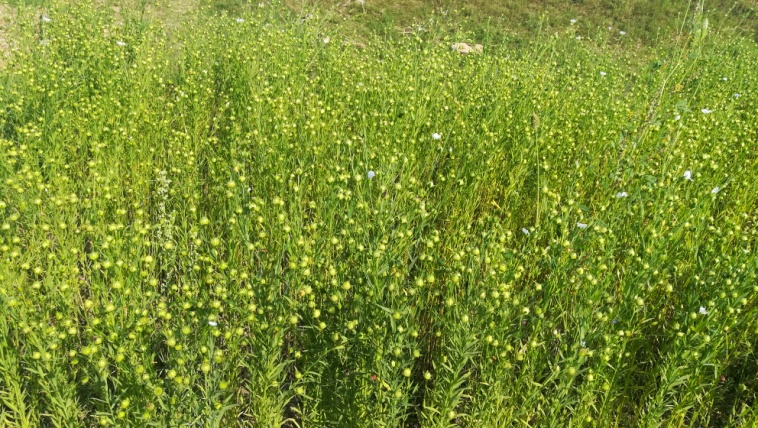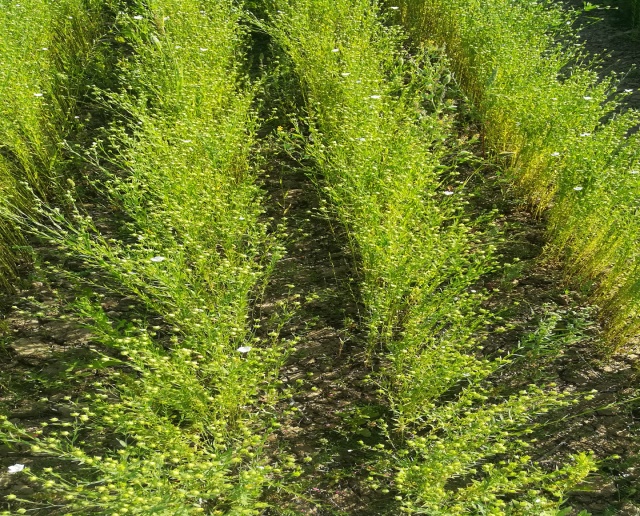अलसी की वैज्ञानिक खेती
Flax is an oldest grown fiber crop in the world. It is a self pollinated crop and the scientific name of flax is Linum usitatissimum L. (n= 15) Usitatissimum means ‘most useful’. Synonyms of flax are Linseed, Common flax, Lint bells, Toad flax, Flax weed and Alsi (in hindi). It belongs to the family Linaceae and genus Linum. Most believed that flax originated from Mediterranean Sea near India.
Flax is an annual herbaceous plant of 12 to 48 inches height, leaves are linear, ovate or lanceolate attenuated at both end , flowers are small about 2.5 cm long and bluish violet in colour. The flowers have five petals; flowers are self-pollinated, although cross pollination is possible. The fruit is a round capsule, divided into five chambers and each chamber containing up to two seeds of yellow or brown colour (at maturity).
Flax (Linseed) is a dual purpose crop grown for fiber and oil. The fiber obtained from the stem of flax type and oil from the seeds of linseed type. The flax seed contain 37 to 43 % oil. Most of the oil is used for manufacturing paints, varnishes, soaps, ink and very small amount of oil is used for edible purposes.
Flax is cultivated in maximum part of India, but still every year India spent approximately 1000 cores of rupees for the import of flax fiber from Canada, China, Belgium and France to fulfill the indigenous demand.
Because of the high demand it is very important to increase the area under production and productivity of Flax. Each and every part of Flax plant is utilized commercially either directly or after processing.
The oil cake of flax is good feed for the cattle and also used as manure. For the emerging bio-fiber industry stem fiber of flax is of considerable interest. Flax fiber is light weight, has good strength and gaining momentum as a key ingredient in manufacture industry.

Linseed Crop
Climate and soil for linseed cultivation
Linseed (Flax) is widely adapted to temperate climates in the world, in India linseed is mainly grown as rabi crop, and sown in last week of October to first week of November. 25-30 ºC temperature is good for the germination of seed and approximately 15-20 ºC during seed formation. But the crop grown for fiber requires still lower temperature (10-19 ºC) and high humidity (76%) the crop is susceptible to frost.
It is grown best in well drained, fertile silt loam, clay loam and silt clay soil. It grows well in soil having pH ranging from 5 to 7. It is well grown in alluvial soil of Indo-Gangetic plain and in black soil of peninsular and central region.
Spacing and seed rate
A row spacing of 20-30 cm with a plant spacing of 7-10 cm is ideal for getting good production. General seed rate of linseed depends on the method of sowing i.e., 40 kg/ha for line sowing and 60 kg/ha for broadcasting method. Seed rate for growing fiber crop is 60 to 80 kg/ha.

Line sowing of Linseed
Cropping system
Linseed is cultivated in monocropping, intercropping and sequence cropping and Paira/ utera cropping. Linseed can be grown in fields where other crop may fail to grow. In rainfed areas linseed is generally grown as intercrop with lentil, wheat, chickpea, barley, safflower etc, to balance the production and to increase monetary return.
Table: Remunerative intercropping of linseed for various states of India
|
Linseed + Chickpea |
2-3 : 1 |
Bihar, Punjab, Bundelkhand region of Uttar Pradesh, WB, Jharkhand, Madhya Pradesh |
|
Linseed + Wheat |
1 : 3-4 |
West Bengal, wheat Maharashtra, Karnataka, Uttar Pradesh |
|
Linseed + Potato |
3:1 |
Karnataka Bundelkhand region of Linseed + Uttar Pradesh |
Nutrient management
Nutrient and moisture stress conditions are the main reason for the low productivity of linseed in India. Applications of organic manures benefit through increasing the water holding capacity of soil which helps in overcome the moisture stress condition. Application of FYM or compost @ of 5-8 kg/ha at the time of land preparation is beneficial for linseed.
Water management
Adequate and timely irrigation is profitable for linseed production; yield can be doubled with 1-2 irrigation given at 35-75 days after sowing. In light soil 3-4 irrigation may be needed. Drought during flowering will reduce the production of both seed and straw, because flowering and grain filling are critical stages for moisture.
Insect-pests and Diseases
There are mainly four diseases which are of economic importance in case of linseed cultivation, i.e., considered as a limiting factor for the good production of linseed.
Most serious fungal diseases of linseed are Fusarium wilt (Fusarium oxysporum f. sp. lini), flax rust (Melampsora lini), Powdery mildew (Odium lini) and Alternaria blight (Alternaria lini). While these all were extremely serious diseases in the past, careful use of crop rotation and the development of varieties resistant to Fusarium and rust have greatly reduced the impact of plant diseases in flax production. Treat flax seed with fungicides to help control seedling diseases
Rust disease of Linseed is caused by Melampsora lini var. lini. Symptoms include presence of bright orange colour powdery pustules mostly present on the leaves, but in severe condition symptoms can also observed on the stems and ball.
The pustules produce several urediospores and these urediosppores are mainly airborne and can cause new cycle of infection during the season. Use of clean seed, seed treatment with oxycarboxin and growing resistant varieties help in reducing the losses.
Insects
Insect pests are rarely a problem in flax production. The most widely cited insect pests of flax are cutworms, wireworms, aphids, grasshoppers, aster leafhopper, tarnished plant bug, and beet webworm. Most can be controlled or reduced using cultural practices, insecticides, and crop rotation.
Reference
Flax Council of Canada. Growing flax,https://flaxcouncil.ca/wp-content/uploads/2015/02/FCOC-growers-guide-v11.pdf
Rai, M. (2012) oil seed. Hand book of agriculture, pp 1186-1194.
Rashid, N., Dar, P. A., Ahmad, H. N., & Rather, S. A. (2018). Alsi (Linum Usitatissimum (Linn.): A potential multifaceted Unani drug. Journal of Pharmacognosy and Phytochemistry, 7(5), 3294-3300.
Singh, S. K., & Manibhushan, K. A. (2018). Organic linseed (Tisi) farming: a step towards doubling farmers’ income. Indian Farming, 68(1), 55-58.
Authors
Puja Kumari, Ram Niwas* and Ramesh Nath Gupta
Email:
